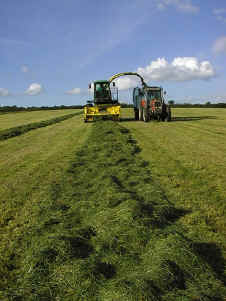MEADOWS
The Decline of Meadows
 |
 |
Intensive grasslands have replaced the traditional hay meadow
| Farming has changed beyond all recognition in the last
60 years. World War II provided the impetus to take as much land as possible into
cultivation, to feed a population cut off from traditional supply routes. Such has been
the continuing pressure that even those areas unsuitable for agriculture without a great
deal of remedial work, have been altered and pressed into service to feed our ever-growing
population. In the 1930's, Britain's farmers produced enough food to feed 16 million
people. Today, they produce enough to feed 40 million people. People need to be fed.
As a result, many habitats that were once common have dwindled into sad remnants of their
former glory. Meadows are a habitat created by centuries of traditional farming practices. They are low input, low output systems for feeding relatively small numbers of cattle and sheep. Increasing economic pressures on farmers mean that cattle and sheep must be kept in ever increasing concentrations in order to produce a profit. In addition, the advent of BSE has meant that animals over 30 months old cannot enter the human food chain. All beef cattle must therefore be reared to suitable weights as rapidly as possible. In order to do so, they have to be fed large quantities of high quality food. This means that most grass pastures are managed intensively to produce the best crop of grass possible, either for direct grazing, or for the production of the winter feed known as silage. Intensive cultivation of grasslands has allowed farmers to improve their grass yields from about 1 tonne an acre to 15 tonnes. To achieve this, special cultivated grass varieties are sown, fertilizers are applied in large quantities and herbicides are commonly used. All of this will prevent the development of meadows and their greater diversity of life. Meadows survive only where it is too uneconomic to manage them intensively, usually because of inhospitable terrain, or poor fertility. Ninety seven percent of the meadows present in the 1940's, have now disappeared, along with vast areas of habitat for a great diversity of plants and animals. Not all of the losses are due to changes in the intensity of farming. The increasing need for space for spreading human populations and more rarely the lack of management of meadows so that scrub and woodland take over, are all factors in their decline.
|
